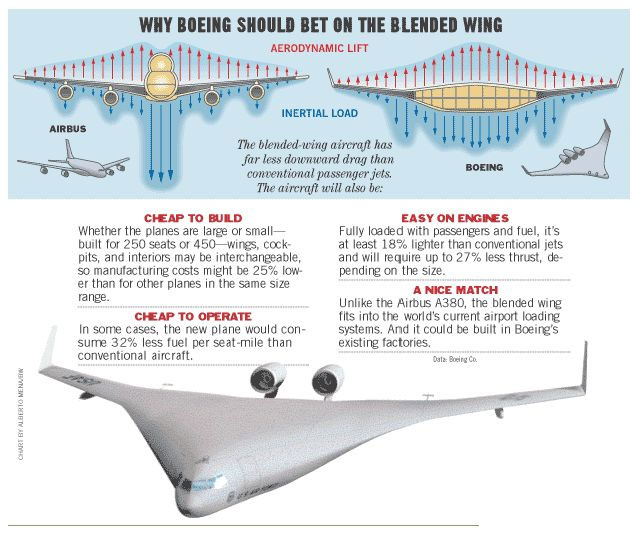The November 25, 2002 issue of Business
Week magazine had an excellent article on the Boeing Blended
Wing.
Offering advantages such as:
- 32% Lower
fuel cost per passenger mile.
- 15% Lower operating costs
than a 747.
- 25% Lower manufacturing costs.
One
would think Boeing would have this craft in project to offset
the market share gains made by Airbus. Especially since the
airlines of the world rejected the Sonic Cruiser which offered
higher speed with higher costs.
The message was clear, the
flying public wants economy.
So why is the project stalled?
Boeing management says off the record, �the airplane lacks
windows, the public won�t accept it!�
Critics say
the BBW was conceived by Boeing�s acquisition McDonnell Douglas,
so the �not invented here� syndrome has kicked in and Seattle
management lacks interest in the project.
What makes
the BBW so efficient? As the diagram below illustrates, the
inertia (read weight) of the aircraft is carried at the point
where it is lifted, unlike a conventional airplane where weight
from the fuselage has to be translated out to be distributed
along the span of the wing.
 Plus a conventional airplane has a horizontal
and vertical tail to keep the airplane pointed in the right
direction. With the BBW, these dead weight items plus the aft
fuselage and the drag component associated with these structures
is not required. Little wonder the BBW is so efficient.
Plus a conventional airplane has a horizontal
and vertical tail to keep the airplane pointed in the right
direction. With the BBW, these dead weight items plus the aft
fuselage and the drag component associated with these structures
is not required. Little wonder the BBW is so efficient.
While it could be argued that without computer control,
the airplane would be uncontrollable. It is true of a lot of
airplanes flying today. But with triple redundant fly-by-wire
systems, loss of control from a failure can be virtually eliminated.
This technology is certainly in a mature stage of development.
|
|
